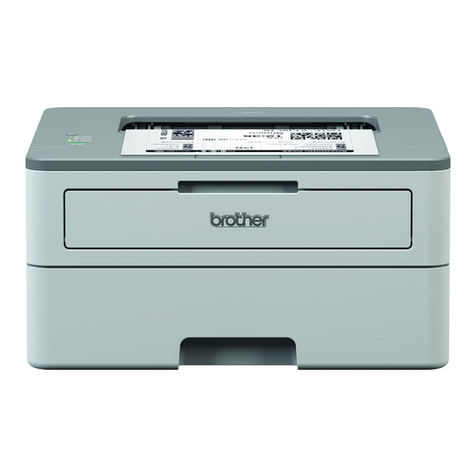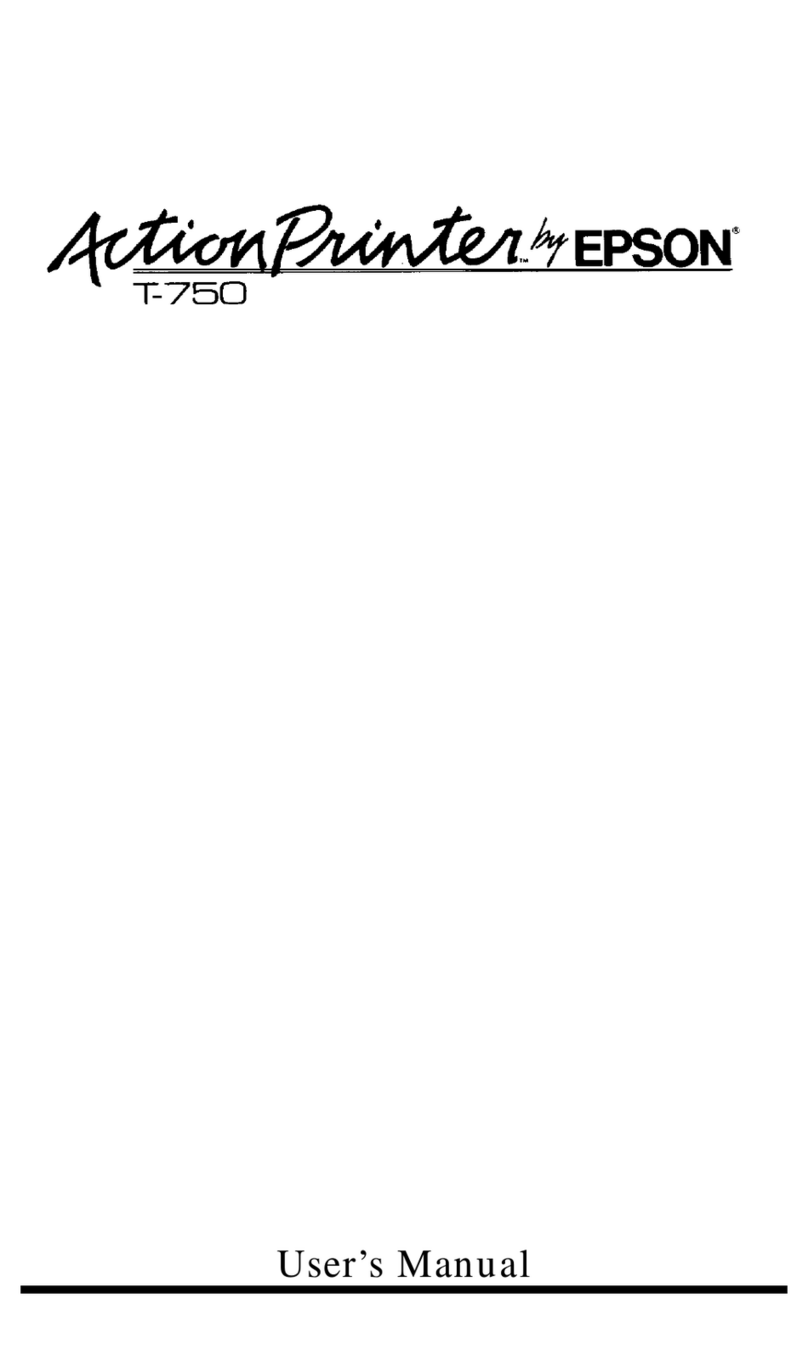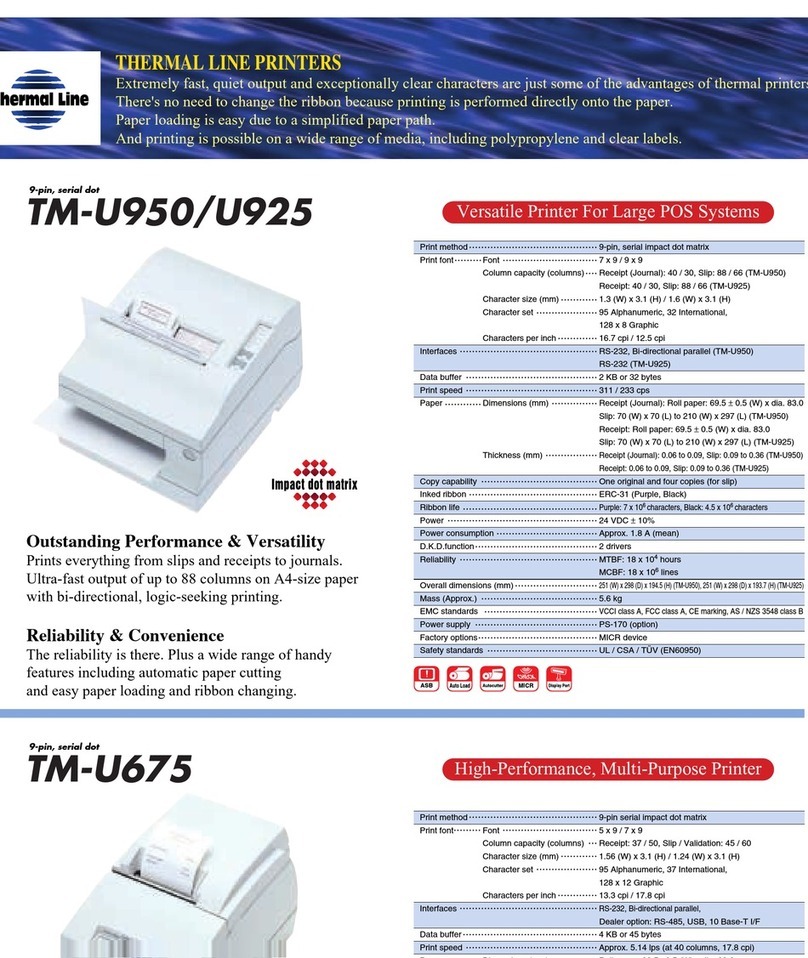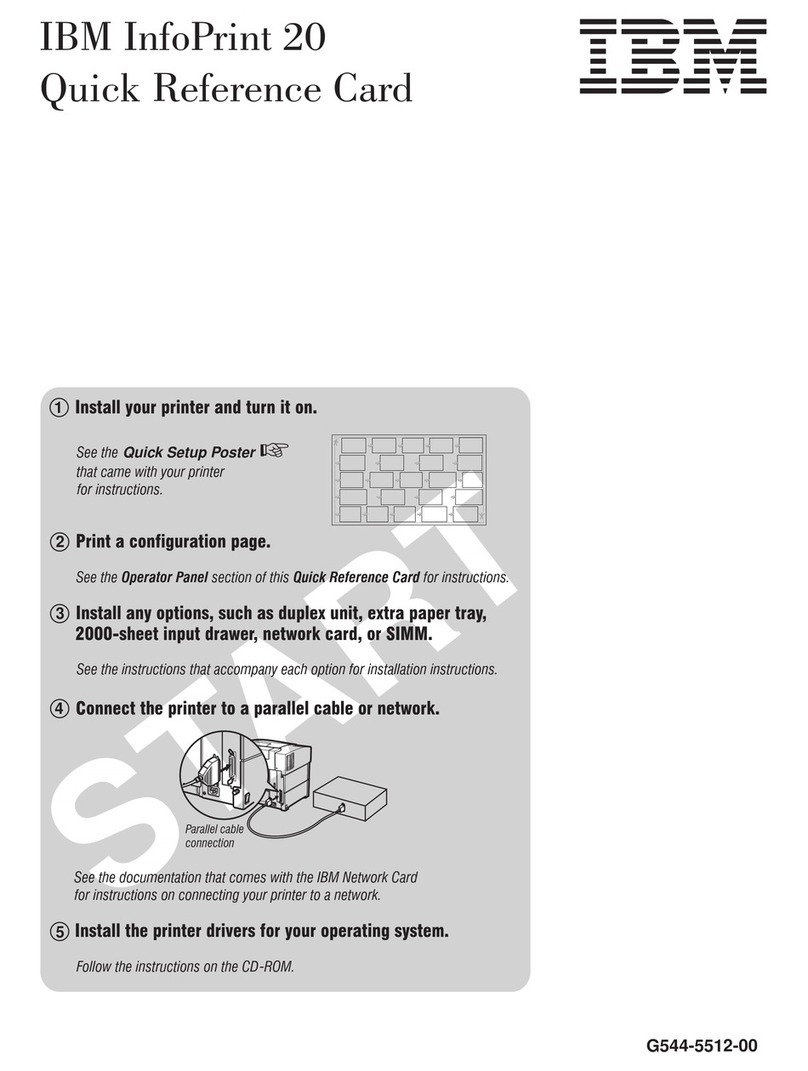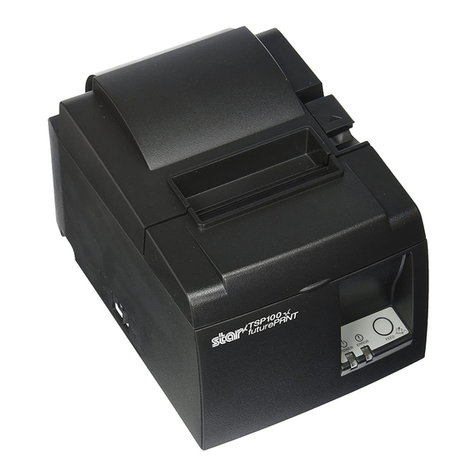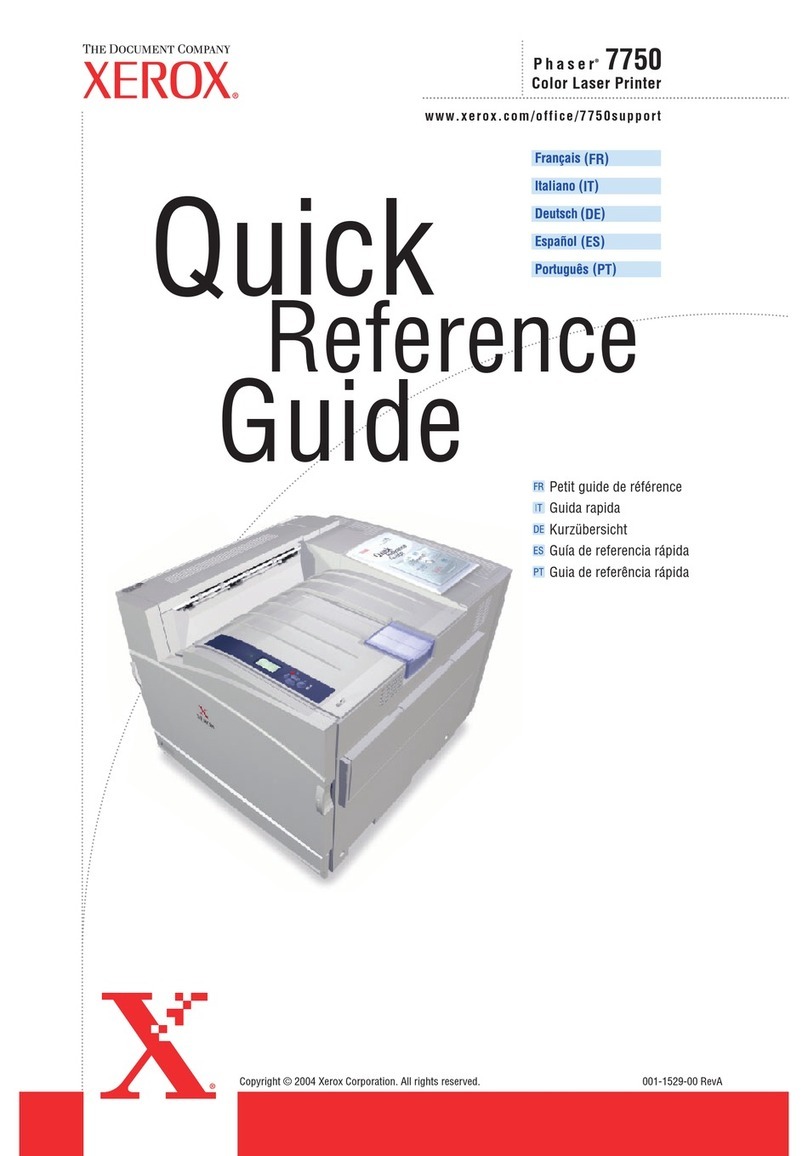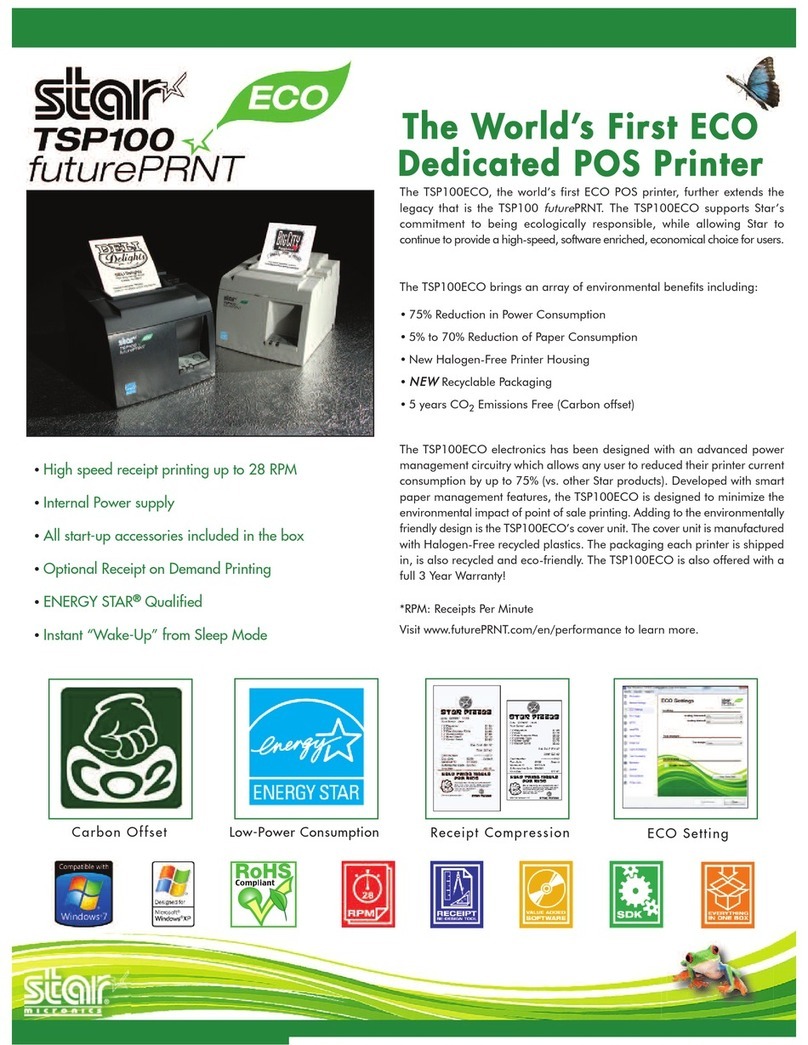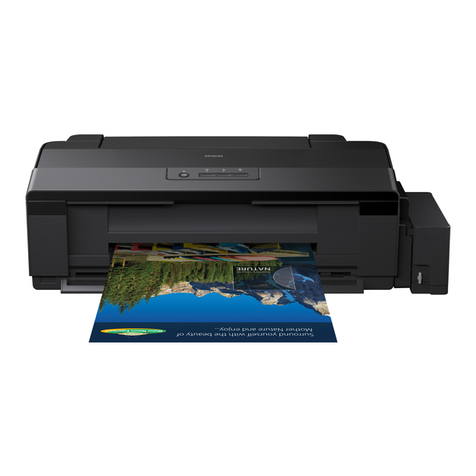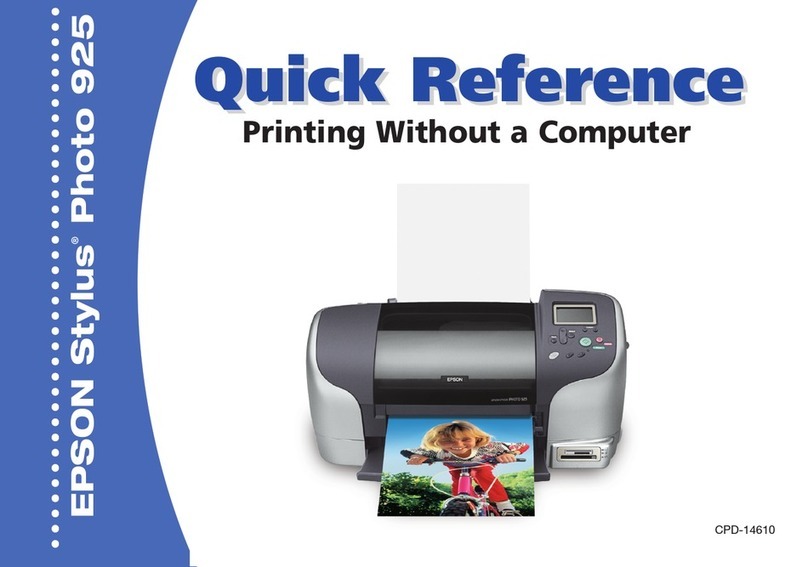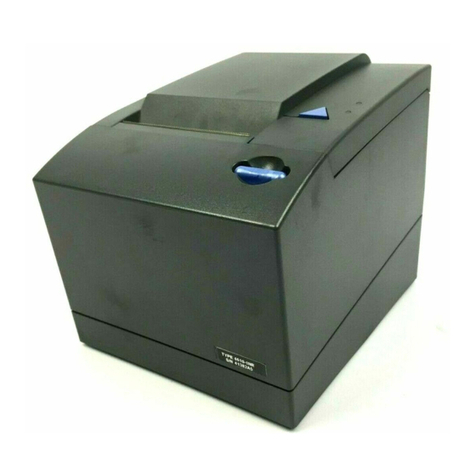Gedge Systems GS8920 Manual

GS8920 Intelligent Ticket Printer.
Issue 05 Copyright 2006 Gedge Systems. GS Systems Pty Ltd A.C.N. 005 647 209
GS8920 INTELLIGENT TICKET PRINTER
OPERATING & INSTALLATION MANUAL.
488 Church Street, Richmond, Victoria 3121 Australia
Phone: +61 3 9429 8396 Fax: +61 3 9429 8097
Email: inf@gedgesystems.com.au

CHANGE NOTICE ISSUE 2.1
Version SA2.0 or higher on power up are YEAR 2000 COMPLIANT.
To ensure year 2000 compliance, these GS8920 Printers ONLY print the time and date
using an internally fitted Option BR2 time and date chip. Time and date data is no longer
accepted from weight indicators connected to the GS8920. See pages A-10 and 3-4 for
further details.
CHANGE NOTICE ISSUE 05 OF THIS MANUAL
Methods of Clearing the TARE registers clarified. Information added to the manual
concerning the installation and use of the GS8920 Printer with the GS1650Mk3/v2
Multi-Range/Multi-Interval Indicator. These are manual change only. They apply to all
GS8920 models regardless of their software version.
Gedge Systems expressly disclaims all responsibility for the
direct and indirect consequences to each and every party
whatsoever, in respect of the use or application of this product
or any other Gedge Systems product if it is used in any way
whatsoever beyond or outside the specified purpose for which it
was supplied.
The contents, format and authorship of all material produced
or printed by any medium, by or on behalf of
GS Systems Pty. Ltd., is the subject of strict proprietorship of
and by GS Systems Pty. Ltd., and cannot be copied,
reproduced, plagiarized or used in part or in whole either
directly or indirectly by any party whatsoever without the
prior written consent of GS Systems Pty. Ltd. This
publication, all of its parts and all matters derived from it,
forms part of such material.

PHYSICAL
MFast and Easy Installation. :-
1. Fit Option 02 EIA RS-232C or Option 05 20mA Current Loop Serial Output board to any GS Weight
Indicator and select ANY baud rate in the range 600 - 19200 baud and ANY parity.
2. Select the weight indicators C3 serial output with beg/end and block divide characters number 06.
3. Connect the GS8920 Printer to the GS weight indicator using the interconnecting cable provided, apply
power and start accumulating weight ! ( No messy switches and internal settings to worry about !) The
GS8920 AUTOMATICALLY determines if the input is EIA RS-233C or 20mA Current Loop and
AUTOMATICALLY determines the baud rate and parity settings and then sets itself to properly receive
the serial data.
4. Use GS8920 digital setup parameters to enhance the operation or the printout if required.
MCan be connected to most Gedge Systems digital weight indicators and other selected
digital weight indicator products.
MConnect any number of weight indicators to the GS8920 Printer via a simple low cost
multi - pole switch. The GS8920’s automatic error correction allows trouble free
switching of the serial input AND if a Gedge Systems weight indicator is used, the
indicator’s device number is printed on the ticket to identify the scale.
MSmall size desk mount - occupies only 300mm by 260mm desk space.
MVery high precision - all arithmetic to 12 digits with multiplication result to 24 digits -
exceeds the number of digits used in most calculators and computers.
MExtensive user customization via user entered ticket heading, descriptors for IDs, material
descriptions, print size/enhancement and print positioning - virtually eliminates the need
for pre - printed tickets.
MExtensive self checking and error reporting. ( Over 16 prompt messages and 12 error
messages. )
M50 Accumulators each with :-
12 digit Gross memory.
12 digit Tare memory.
12 digit Net memory.
12 digit Transaction counter.
12 digit total quantity memory for item entry/counting.(requiresBR2)
12 digit total cost memory for item entry/counting.(requiresBR2)
12 digit total weight memory for item entry/counting.(requiresBR2)
6 digit numeric material code number or
12 Alpha/Numeric material code from the ALPHA name table.
Time/Date last cleared memory.
M50 Tare weight memories automatically assigned for key tare entry or weigh in/weigh out
use.
MALPHA name table comprising 50 memories which each hold up to 12 alpha/numeric
names entered by the user. The names can be assigned as material descriptions, ticket
headings and ID number descriptions.
M1 Security Register with :-
12 digit Gross memory.
12 digit Tare memory.
12 digit Net memory.
12 digit total quantity memory for item entry/counting.(requiresBR2)
12 digit total cost memory for item entry/counting.(requiresBR2)
12 digit total weight memory for item entry/counting.(requiresBR2)
12 digit Transaction counter.
12 digit Rolling print counter.
Time/Date last cleared memory.
MOne retained 6 digit numeric ID Number which may be selectively printed as 1 six digit
number, as 2 three digit numbers or as 3 two digit numbers.
MUp to nine printed 6 digit ID codes with up to 6 of these ID codes having user entered 12
character alpha/numeric names.
M15 key sealed membrane keyboard with audio feedback.
M6 digit Numeric Display
M8 Status/Display Lamps.
FEAT-1
GS8920 Intelligent Ticket Printer - Features.

MHigh quality printhead.
MBattery backed memory saves all data which is checked for corruption on power up.
MMicroprocessor Watchdog Circuit.
MHigh Quality/High Reliability construction.
MAll metal enclosure.
M1 Interlock Input to allow lockout of functions NOT requiring operator access.
M1 Sealable Input to lock out access to the GS8920’s set up parameters.
MUser initiated print test at power up.
MOptional BR2 internal calendar/clock and expanded RAM for item entry and counting.
MOptional Serial Output duplicates ALL front panel printer operations on user’s remote
security printer.
FEAT-2
This example shows the use of
double wide/double high printing;
leading zero suppression and al
-
pha/numeric materials codes as
well as stored/recalled tare weights,
ID numbers together with page
headings and Item Entry/Pricing.

OPERATION
MOperates with ALL serial output equipped GS digital weight indicators as well as other
selected digital weight indicators.
MItem entry of quantity and price for piece computing and counting. (requires Option BR2)
MUses either the time and date from the GS digital weight indicator or the time and date from
the optional calendar/clock fitted within the GS8920.( Option BR2 Calendar/Clock)
MCompletely Automatic RS-232C or 20mA Current Loop input selection as well as Baud rate
and parity bit setting at power up. No need to EVER set the baud rate or parity setting.
MFull Digital Setup using the front panel keyboard. Access to the inside of the GS8920 is NOT
required.
MVery extensive user configurable print format provides over 9,000 possible printed
configurations for the weight printout.
MMultiple copies available on CARD stock via the “COPY” print feature.(Up to 4 additional
copies are available. )
MFully Automatic ticket positioning to wide range of settable starting positions.
MFully Automatic ticket ejection settable to front, rear or off.
MStandard ticket sensors for top of form and bottom of form.
MAutomatic ticket request message if ticket not inserted.
MKeyboard Entry/Store and Recall up to 50 tare values which are checked for legal range by
the GS8920.
MAutomatic tare allocation for Weigh In and Weigh Out operation.
MAdd up to 30 weights to form one weighment or just 2 weights for end to end weighing.
MInterlock access to the Totals and Security Registers and Alpha names.
MInterlock access to the GS8920’s set up.
MAdd to or Subtract from any one of 50 Accumulators.
MPrint/Accumulate only Gross or only Net weight or Gross, Tare and Net weight.
MSelectable Rolling Print Counter on all tickets.
MSelectable Left or Right Line Justified Printing.
MSelectable line indent of up to 11 character spaces.
MSelectable page justification via normal or inverted printing for all possible page justifications
against left or right side of page.
MSelectable leading zero suppression. Proper zero rules automatically apply. The GS8920 prints
“0.0" for zero with decimal places and ”00" for zero with count by 10, 20 or 50.
MSelectable Print test at power up.
MNo data loss when out of paper.
MAdjustable normal size printing from 1.6mm high to 3.6mm high by 1.6mm wide.
MAdjustable enhanced printing, double high 3.2mm to 7.2mm high by 1.6mm wide, double
wide 1.6mm to 3.6mm high by 3.2mm wide and double high/double wide 3.2mm to 7.2mm
high by 3.2mm wide.
MSelectable print enhancement; choose weight, ID Number or Weight and ID Number.
MSelectable interline spacing from 0.7mm up to 7.9mm for normal high and 1.4mm up to
15.8mm for double high printing.
MAutomatic Page Numbering for printed lists of the Security Register and Accumulators.
MFollowing an Accumulate command the GS8920 can be configured to either :-
1. Abort on Motion.
2. Await a still condition and then accumulate a weight.
3. If still to first await a motion condition then a still condition before accumulating a weight.
FEAT-3

A Description and Overview of the GS8920. A-1
A .1 Overview and Physical Description. A-1
A .1 .1 Overview. A-1
A .1 .2 Physical Description. A-2
A .2 The GS8920’s Memory Registers. A-3
A .2 .1 Introduction. A-3
A .2 .2 Summation Register A-3
A .2 .3 ID Number Register A-4
A .2 .4 Tare Registers A-4
A .2 .5 Accumulators (AC) A-5
A .2 .6 Alpha/Numeric Name Table. A-6
A .2 .7 Security Register ( SEC REG) A-7
A .3 Active Memory Registers. A-8
A .3 .1 General. A-8
A .3 .2 Active Accumulator - Description and What it Means. A-8
A .3 .3 Active Tare - Description and What it Means. A-8
A .4 Weight Data Input to the GS8920. A-9
A .4 .1 General A-9
A .4 .2 Signal type, Baud Rate and Parity. A-9
A .4 .3 Weight Data Message String. A-10
A .4 .4 Time and Date Data. A-10
A .4 .5 Print Weight Operation. A-10
1 Using the GS8920 Ticket Printer 1-1
1 .1 About this Section 1-1
1 .2 The GS8920’s Front Panel Keyboard, Display and Lamps. 1-1
1 .2 .1 Introduction. 1-1
1 .2 .2 Display and Lamps. 1-2
1 .2 .3 Keyboard Controls 1-2
1 .2 .3 .1 The GS8920’s Normal Operating Mode. 1-3
1 .2 .3 .2 Key Descriptions and Uses. 1-3
ID/0 Key. 1-3
AC+/1 Key. 1-3
AC-/2 Key. 1-3
WEIGH IN/3 Key. 1-3
WEIGH OUT/4 Key. 1-3
CODE WT/5 Key. 1-4
SEC REG/6 key. 1-4
TOTALS/7 Key. 1-4
FEED/8 Key. 1-5
SUM/9 Key. 1-5
PRINT Key. 1-5
AC Key. 1-5
TARE Key. 1-5
ENTER Key. 1-5
CLEAR Key. 1-5
1 .3 The Meaning of the GS8920’s Prompt and Error Messages. 1-6
1 .3 .1 Prompt messages. 1-6
COPY 1-6
PAPEr 1-6
—— 1-6
-Errt- 1-6
-Locd- 1-6
ALPHA 1-6
-Clr- 1-6
-Prn- 1-6
Su 01 1-7
Ac xx 1-7
TOC-1
GS8920 Intelligent Ticket Printer - Table of Contents.

tr xx 1-7
-Id x- 1-7
—nr— 1-7
-SEt- 1-7
COUNt 1-7
PrICE 1-8
1 .3 .2 Error Messages. 1-8
-Err01- 1-8
-Err02- 1-8
-Err03- 1-8
-Err04- 1-8
-Err05- 1-8
-Err06- 1-8
-Err07- 1-8
-Err08- 1-9
-Err09- 1-9
-Err10- 1-9
-Err11- 1-9
-Err12- 1-9
1 .4 The GS8920’s Major Day to Day Functions and How to Use Them.1-9
1 .4 .1 Introduction 1-9
1 .4 .2 Entering and Printing ID Numbers. 1-10
1 .4 .3 Selecting an Accumulator. 1-12
1 .4 .4 Entering a Material Code Number or an Alpha Material Description Reference.1-13
1 .4 .5 Selecting a Tare Register. 1-14
1 .4 .6 Entering a Tare Weight via the GS8920 Keyboard. 1-15
1 .4 .7 Adding a Transactions Weight to an Accumulator with Copy. 1-16
1 .4 .8 Creating a Truck “Weigh In” Ticket with Copy. 1-17
1 .4 .9 Creating a Truck “Weigh Out” Ticket with Copy. 1-18
1 .4 .10 End to End Weighing/Adding weights together using SUM. 1-19
1 .4 .11 Listing the Contents of the Accumulators and Tare Register. 1-20
1 .4 .12 Clearing the Contents of the Accumulators. 1-21
1 .4 .13 Item Entry/Piece Counting and Pricing. 1-22
1 .4 .13 .1 Item Entry with known Quantities 1-22
1 .4 .13 .2 Item Entry with unknown Quantities 1-23
1 .5 Using and Entering Alpha Names. 1-25
1 .5 .1 General 1-25
1 .5 .2 Accessing the Alpha Name Routines 1-25
1 .5 .3 Descriptors for ID numbers. 1-25
1 .5 .4 Names for Ticket Headings. 1-26
1 .5 .5 Names/Numbers for each Accumulator as Material Codes. 1-26
1 .5 .5 .1 General 1-26
1 .5 .5 .2 Giving an Accumulator a Numeral Material Code. (Entering a Code Number.)1-26
1 .5 .5 .3 Giving an Accumulator a 12 Character Description as a Material Code. 1-26
1 .5 .6 Listing the Names which are Assigned to Accumulators. 1-27
1 .5 .7 Listing all of the Alpha Names in Memory. 1-27
1 .5 .8 Entering and Changing Alpha Names. 1-27
1 .6 Examples of the GS8920’s Tickets and Lists. 1-29
1 .6 .1 Enhanced Printing and Zero Suppression 1-29
1 .6 .2 Tickets Printed when Accumulating a Weight. 1-30
1 .6 .2 .1 Gross, Net and Tare Weight from the Weight Indicator. 1-30
1 .6 .2 .2 Gross Weight from the Indicator, Tare Weight from a Tare Register. 1-31
1 .6 .2 .3 Gross Weight from the Indicator, Tare via Keyboard PLUS Item Entry/Pricing.1-32
1 .6 .2 .4 Summing Weights. (End to End Weighing) 1-33
1 .6 .2 .5 Weigh In 1-34
1 .6 .2 .6 Weigh Out 1-35
1 .6 .2 .7 Shorter & Different Ticket printouts. 1-36
1 .6 .3 Printing Totals 1-37
1 .6 .3 .1 Printing the Security Register Totals. 1-37
TOC-2

1 .6 .3 .2 Printing the Accumulator Totals 1-38
1 .7 Applying Power to the GS8920. 1-40
1 .7 .1 The GS8920’s Display Messages When Power is Applied. 1-40
Pt0.0bt 1-40
888888 1-40
blank 1-40
—nr—. 1-40
-232C- 1-40
C LOOP 1-40
bd 4800 1-40
Err08 1-40
PA E 1-40
PA n 1-40
Ac 50 1-40
1 .7 .2 Status and Memory Checks. 1-41
1 .7 .3 Option P1 Serial Output Verification. 1-41
1 .7 .4 Test Print at Power Up. 1-41
1 .8 Replacing the Ticket Printer Ribbon. 1-42
1 .9 Inserting a Ticket into the GS8920. 1-43
1 .10 Periodic Maintenance. 1-43
1 .11 Electrical Supply. 1-43
2 Installing the GS8920 Ticket Printer. 2-1
2 .1 About this Section 2-1
2 .2 Installation Steps. 2-1
2 .3 Unpacking 2-1
2 .4 Digital Setup 2-1
2 .4 .1 Introduction. 2-1
2 .4 .2 Digital Setup Keys. 2-2
2 .4 .3 Digital Setup Parameters. 2-3
2 .4 .3 .1 Header. 2-4
2 .4 .3 .2 Item Entry. 2-4
2 .4 .3 .3 Decimals, Average Weight. 2-4
2 .4 .3 .4 Decimals, Price. 2-5
2 .4 .3 .5 Item Entry Zero Blanking. 2-5
2 .4 .3 .6 Currency Units 2-5
2 .4 .3 .7 Print G, N or All. 2-5
2 .4 .3 .8 Alpha Name Table. 2-5
2 .4 .3 .9 Id Punctuation 2-5
2 .4 .3 .10 Id Names (descriptors) 2-6
2 .4 .3 .11 Print Counter. 2-6
2 .4 .3 .12 Leading blanks.(Zero suppression.) 2-6
2 .4 .3 .13 Units of Measure. 2-6
2 .4 .3 .14 Character Height 2-6
2 .4 .3 .15 Interline Spacing 2-6
2 .4 .3 .16 Enhanced Printing. 2-6
2 .4 .3 .17 Line Justification. 2-7
2 .4 .3 .18 Side Margin. 2-7
2 .4 .3 .19 Page Justification. 2-7
2 .4 .3 .20 Top Margin, Normal 2-7
2 .4 .3 .21 Top Margin, Lists 2-7
2 .4 .3 .22 Top Margin Adder 2-7
2 .4 .3 .23 Copy 2-7
2 .4 .3 .24 Eject Ticket 2-8
2 .4 .3 .25 Tare Entry. 2-8
2 .4 .3 .26 Count by. 2-8
2 .4 .3 .27 Indicator Type. 2-8
2 .4 .3 .28 AC+/- Print 2-9
TOC-3

2 .4 .3 .29 Automatic Print. 2-9
2 .4 .3 .30 Remote Print 2-9
2 .5 Connecting the GS8920 to Digital Weight Indicators. 2-9
2 .5 .1 Serial Data Input. 2-9
2 .5 .1 .1 Connecting the GS8920 to Several Weight Indicators. 2-9
2 .5 .1 .2 Connection to GS Weight Indicators. 2-10
2 .5 .1 .3 Connection to Toledo Weight Indicators. 2-10
2 .5 .1 .4 Connection to A&D Weight Indicators. 2-11
2 .5 .1 .5 Interconnecting Cable. 2-11
2 .5 .2 Sealing the GS8920. 2-12
2 .5 .3 Interlock Switch. 2-12
2 .6 GS Digital Weight Indicator Setup. 2-12
2 .6 .1 General 2-12
2 .6 .2 Option 02 and 05 Baud Rate. 2-13
2 .6 .3 Data Parity 2-13
2 .6 .4 Data Format 2-13
2 .6 .4 .1 GS1650 Parameter Settings. 2-13
2 .6 .4 .2 GS1650 BR3, GS1650A, GS1650B and GS2750. 2-13
2 .7 Ticket Layout. 2-14
3 OPTIONS 3-1
3 .1 About this Section. 3-1
3 .2 Field Installed Serial Output Option P1. 3-1
3 .2 .1 General. 3-1
3 .2 .2 Option P1 Installation. 3-2
3 .2 .3 Option P1 Connector. 3-3
3 .3 Factory Installed Calendar/Clock and Item Entry Option BR2.3-3
3 .3 .1 General. 3-3
3 .3 .2 Setting the Time and Date. 3-4
3 .3 .3 Date/Time - Printed Formats. 3-4
3 .3 .4 Item Entry and Pricing. 3-4
4 TECHNICAL SPECIFICATION. 4-1
4 .1 Basic Printer 4-1
4 .2 Factory Installed Option. 4-3
4 .3 Field Installed Options. 4-3
4 .4 Ordering Guide. 4-3
5 WARRANTY 5-1
5 .1 Definition. 5-1
5 .2 Extent. 5-1
5 .3 Warrants. 5-1
5 .4 Repair/Replace/Exceptions. 5-1
5 .5 Shipping Costs. 5-1
TOC-4

A Description and Overview of the GS8920.
A .1 Overview and Physical Description.
A .1 .1 Overview.
The GS8920 Ticket Printer forms part of the rapidly expanding GS family of non redundant intelligent
microprocessor based instruments designed specifically to satisfy the needs of modern industrial
weighing.
The GS8920 Ticket Printer incorporates the common thread running through all of the range of GS
products - it is versatile, intelligent, expandable and can be used in conjunction with pre-existing GS
digital weight indicator products as well as a range of other popular brand digital weight indicators.
In the above figure, the GS8920 Ticket Printer is connected to one GS digital weight indicator. The
indicator may be connected to a weighbridge or a platform scale or, in fact, any weighing device.
The GS8920 Ticket Printer may be connected to virtually any number of GS digital weight indicators
via a low cost multi - pole switch. The GS8920 includes software which allows simple switching of the
serial input line without causing an operational failure of the GS8920. Additionally, the GS8920 Ticket
Printer includes the GS indicator’s device number on the printed ticket and so allows the scale from
which the weight information was transmitted to be identified on the ticket.
As a standard security measure, access to the digital setup routines may be locked out at 3 levels by a
keystroke procedure, a remote user supplied keyswitch and an interlock in the rear connector which
may be wire sealed in place. Access to the security registers, the accumulated totals, the accumulator’s
material codes, the name table assignments and the Alpha Name table may also be locked out via a
user supplied remote keyswitch.
GS8920 Intelligent Ticket Printer.
A-1
Fig.A-1Application Overview.
GS8920 PRINTER.
To User’s Remote Copy printer.
User’s Remote
Interlock Keyswitch

As an option and a further security measure, the GS8920 Ticket Printer may be fitted with a serial
output board, which, when connected to the user’s printer, will produce a copy of every printout as the
GS8920 prints them.
A .1 .2 Physical Description.
The standard GS8920 Ticket Printer, shown in the figures below, provides in its basic form an
extensive array of features to enable its economical use in conjunction with a digital weight indicator in
a very wide range of applications. The basic GS8920 Ticket Printer comprises a serial input port, a
wire sealable interlock input, an interlock input for use with remote key switches, CPU watchdog
circuit, battery backed memory, a high quality ticket printer mechanism and a front panel
keyboard/display all under control of the microprocessor CPU.
An options expansion socket is provided which will accept a field fitted Option P1 Serial Output. The
serial output may be connected
to a remote security printer
upon which is produced a copy
of every GS8920 printed
transaction.
An additional expansion socket
is provided which will accept
the factory fitted Option BR2
Calendar/Clock and Expanded
RAM for time and date printout
as well as item entry and piece
counting.
GS8920 Intelligent Ticket Printer.
A-2
Fig.A-2GS8920 Inputs and
Outputs.
EIA
RS-232C or
20mA CL
Serial
Weight Data
from GS
and popular
Optional EIA RS-232C
and EIA RS-422A
Serial Outputs for
remote copy of ALL
1 - Standard Optically Isolated Interlock Input.
Fig.A-3GS8920 Printer Block Diagram.
FRONT PANEL KEYBOARD AND DISPLAY.
SERIAL INPUT
CPU
WATCHDOG
CIRCUIT
BATTERY
BACKED
MEMORY
SERIAL WEIGHT DATA
FROM THE DIGITAL
WEIGHT INDICATOR.
SLOT FOR P1
SERIAL OPTION.
PRINTER
MECHANISM
1 - INPUT
INTERLOCK INPUT for
USERS KEYSWITCH.
OPTION BR2
CALENDAR/CLOCK
and RAM
1 - SEALABLE
INPUT
JUMPER SEAL

A .2 The GS8920’s Memory Registers.
A .2 .1 Introduction.
The GS8920 Ticket Printer includes, in its
basic configuration, 8K bytes of battery
supported memory, a part of which is
used for retaining all of the user’s settings
and accumulated weights.
Option BR2 provides, in addition to a
calendar/clock, an additional 2K bytes of
battery supported RAM which is used for
the GS8920’s item entry and piece
counting facility.
The memory is divided into the following
registers whose structure and function is
fully explained in the following sections.
50 - Accumulator Registers.
1 - Alpha Name Table of
50 Alpha/Numeric Names
for Material Codes, headings
and ID’s.
50 - Tare Registers.
1 - ID Number Register.
1 - Security Register.
1 - Summation Register.
A .2 .2 Summation Register
One 12 digit weight register which is cleared when first
accessed via the key SUM. Subsequent operations of the
key SUM add the gross weight from the digital weight
indicator to the weight in the summation register.
Up to 30 additions can be made up to a total weight of
999,999,999,999 but generally, though, only two
additions would be made as in the case of truck ‘end to
end’ weighing.
The weight built up in the summation register is used
instead of the digital weight indicator’s input weight in
any of the GS8920 Ticket Printer’s functions.
GS8920 Intelligent Ticket Printer.
A-3
Fig.A-4Memory Organization.
Fig.A-5Summation Register.
12 digit Gross.
Each keystroke of SUM
adds the gross weight
from the indicator to the
SUMMATION register.
Gross Weight
Operation of keys AC +, AC -
WEIGH IN, WEIGH OUT uses
the weight from the
summation register instead
of the current gross weight
from the weight indicator.
50 Tare
Registers.
50 Accumulator Registers.
ID No. Register.
Security Register.
Summation Register.
Alpha Name Table of 50
Alpha/Numeric Names.

A .2 .3 ID Number Register
One permanent 6 digit numeral register containing the ID number
to be printed on each ticket. An ID number of zero is not printed.
The ID number may be configured during installation of the
GS8920 to be printed as 1 six digit number, as 2 three digit
numbers or as 3 two digit numbers.
These configurations provide, among other things, the opportunity
to use this code as a truck, destination and source code.
In addition to the retained ID number held in the ID register, the
GS8920 is able to print up to a further nine 6 digit ID numbers.
These ID numbers are entered and printed but not saved. During
digital setup, the GS8920 can be configured to print up to the first
6 of these ID numbers with a 12 alpha/numeric name from the
alpha name table as an ID descriptor. An example showing all 9
IDs with 6 having descriptors would be :-
Truck 234
Driver 12
Dock 1
Supplier 2345
Shift 5
Weigh Bridge 2
23
4
4237
Each descriptor may be different and each may
contain up to 12 alpha/numeric characters.
A .2 .4 Tare Registers
Fifty tare weight registers numbered from 1 to 50
and each able to contain one 6 digit tare weight.
A tare weight can be entered and stored via the
keyboard or can automatically be entered and stored
by the GS8920 Ticket Printer during the GS8920’s
“weigh in” sequence. A tare weight is recalled for
use via the keyboard by entering its tare number in
the range 1 - 50. A list can be printed of all the non
zero tare weights .
The key tare entry facility is enabled during digital
setup of the GS8920 Ticket Printer. At this time, the
scale maximum capacity and count by is entered to
enable the GS8920 to check the legality of any key
tare weights.
When the key tare facility is enabled, the GS8920
Ticket Printer always uses the tare weight entered
via the GS8920’s keyboard instead of the tare
weight transmitted to the GS8920 Ticket Printer by
the digital weight indicator.
GS8920 Intelligent Ticket Printer.
A-4
Fig.A-6ID Number Register.
6 digit ID number.
ID number up to
6 digits entered
via the keyboard.
ID number
automatically
printed on all
weight transaction
printouts.
Fig.A-7Fifty Tare Registers.
6 digit Tare.
Tare number selected via the keyboard.
Tare weight entered via the keyboard or
automatically during WEIGH IN
Selected tare weight is used in the weight
transactions AC +, AC - and WEIGH OUT.
49
50 6 digit Tare.
48 6 digit Tare.
16 digit Tare.
6 digit Tare.
2
36 digit Tare.

A .2 .5 Accumulators (AC)
50 registers each containing:-
a.Three 12 digit weight accumulators
for Gross, Net and Tare weight.
b. One 6 digit material code register.
c. One 12 digit transaction counter.
d. One 12 digit total price register.
(requires Option BR2)
e. One 12 digit total quantity register.
(requires Option BR2)
f. One 12 digit total weight register
used to calculate the average weight.
(requires Option BR2)
In addition, one date/time register is provided which
contains the date and time when all of the
accumulators were last cleared. The accumulators,
which are numbered 1 to 50, are selected via the
keyboard using their number 1 to 50 to identify
them.
Each accumulator is identified on the ticket by its
number in the range 1 to 50 and by either a 6 digit
material code number in the range 000001 to
999999 or a 12 Alpha/Numeric material description
which has been selected from the alpha name table.
An accumulator becomes active when selected and
remains active until another accumulator is selected.
For every weight transaction, the Gross, Net and
Tare weights are added to the selected
accumulator’s weight memory and the
accumulator’s transaction counter is incremented by
one.
If Option BR2 is fitted and the GS8920’s item entry
feature is being used, then the item’s quantity, total
price and total weight are also added to the selected
accumulator’s quantity, price and weight memory.
As a security feature, the same weights, quantities
and prices are also added to the security register.
All of the accumulated weights, quantities, prices,
average weights and costs per unit of weight can be
printed, together with their grand totals.
In addition, all of the accumulated weights,
quantities, prices and transaction counters can be
cleared. The GS8920 maintains a record of the time
and date when the accumulators are cleared.
The printout and clearing facility can be interlocked
to prevent unauthorized access to the GS8920’s
accumulators by the fitment and use of a remote
keyswitch connected to the GS8920’s interlock
input.
Note :- The time and date are only recorded if this
information is provided by the digital weight
indicator to which the GS8920 Ticket Printer is
connected OR if the GS8920 Ticket Printed is fitted
with Option BR2 calendar/clock.
GS8920 Intelligent Ticket Printer.
A-5
Fig.A-8Fifty Accumulator Registers (AC).
Time & Date when
last cleared.
50 6 digit Code.
Operation of AC+, AC-,
WEIGH IN/WEIGH OUT adds
weight
to the active accumulator and
increments the accumulator’s
transaction counter by 1.
12 digit Gross.
12 digit Net.
12 digit Trans. Count.
12 digit Tare.
6 digit Code.
01
12 digit Gross.
12 digit Tare.
12 digit Net.
12 digit Trans. Count.
02 6 digit Code.
12 digit Gross.
12 digit Tare.
12 digit Net.
12 digit Trans. Count.
ACTIVE
ACCUMULATO
R
Weight will be added
to this, the active
accumulator.
It’s transaction
counter will be
incremented by 1.
12 digit total price.
12 digit total quantity.
12 digit total weight.
12 digit total price.
12 digit total quantity.
12 digit total weight.
12 digit total price.
12 digit total quantity.
12 digit total weight.

A .2 .6 Alpha/Numeric Name Table.
One alpha/numeric name table containing up to 50 names each of 12 characters which may be entered
via the GS8920’s keyboard. Each name in the table has a reference number 1 to 50.
Any name may be assigned to any
accumulator simply by placing the name’s
reference number in the accumulators
code register. One name can be assigned
to 1 or all accumulators or each
accumulator may use a unique name. A
name, once assigned to an accumulator
remains assigned and may be used as a 12
character material description.
Additionally, names numbered 49 and 50
may be used as a ticket heading of two
lines each of 12 characters. The ticket
heading may be selectively printed normal
size or enhanced to double size, double
wide or double wide/double high.
Further, names numbered 40 to 45 may be
assigned to be printed as descriptions for
the first 6 ID numbers which may be
entered via the keyboard and printed.
An example ticket showing the use of
these names in bold is :-
Ajax Meat Co
Melbourne
Driver 9
Truck No 154
Dock No 11
Supplier 1237
Shift 3
Weigh Bridge 2
ID 98/09/12
Ac[01]+ 05-Steers,light
09-27-90 02:29PM
rpc 7654
2653kg G
The name table may be accessed via the keyboard and names are easily added, changed or re -
assigned. A list of all the names in the name table may be obtained as well as a list of which names are
assigned to each of the 50 accumulators.
Access to the alpha name table and the accumulator assignments can be interlocked to prevent
unauthorized changes by the fitment and use of a remote keyswitch connected to the GS8920’s
interlock input.
Note : - The alpha name table facility may be disabled at setup of the GS8920.
GS8920 Intelligent Ticket Printer.
A-6
Fig.A-9Alpha Name Table of 50 names.
12 alpha/numerics.
When the number 1 to 50 is used as the material
code for any of the accumulators the material’s
description is taken from this table.
Any name may be used with any accumulator. Name
10 for example does not have to be used with
accumulator 10.
49
50 12 alpha/numerics.
45 12 alpha/numerics.
112 alpha/numerics.
12 alpha/numerics.
2
312 alpha/numerics.
40 12 alpha/numerics.
Alpha names 40 to 45 may
be used as descriptions for
up to 6 ID numbers.
Alpha names 49 and 50
may be used as ticket
headers.

A .2 .7 Security Register ( SEC REG)
One register containing sub - registers which comprise :-
a.Three 12 digit weight accumulators for Gross, Net and Tare weight.
b. One 12 digit transaction counter.
c. One 12 digit total price register.(requires Option BR2)
d. One 12 digit total quantity register.(requires Option BR2)
e. One 12 digit total weight register used to calculate the average weight.(requires Option BR2)
f. One 12 digit non-resettable print counter which appears on every printed ticket.
Every time a weight transaction is printed, regardless of the accumulator to which the weight will be
added, the Gross, Net and Tare weights as well as the
quantities, total prices and total weights are added to
the security register’s memory.
The security register’s transaction counter is
incremented by one. In addition, if enabled during
installation, the rolling print counter will be
incremented by 1 and then printed upon the ticket.
The time and date, if provided by the weight
indicator or by the fitment of Option BR2, is
recorded whenever the security register is cleared.
The security register has a wide variety of uses apart
from that as a control/security totals register. It may
be used as a general purpose accumulator which does
not require selection prior to use. In a single
accumulator application, this is perhaps the most
useful function for the security register.
The security register IS NOT cleared when the
normal weight accumulators are cleared. The weight,
quantity and price information in the security register
will therefore only equal the total of the weights in
the accumulators 1 - 50 if the accumulators and the
security register are cleared at the same time.
Otherwise, the security register will contain all of the
weight, quantity and price information that has been
added to the accumulators numbered 1 to 50 since
the security register was last cleared.
Printout and clearing of the security register can be
interlocked via the fitment and use of a remote
keyswitch connected to the GS8920’s interlock input.
Reference to quantity and price applies only if the
GS8920’s item entry facility is enabled by fitment of
Option BR2.
GS8920 Intelligent Ticket Printer.
A-7
Fig.A-10 Security Register (SEC REG).
12 digit Tare.
Operation of keys AC +, AC -
WEIGH IN, WEIGH OUT adds
weight, quantity and price to the active
accumulator AND the security
register.
12 digit Gross.
12 digit Net.
Time & Date when
last cleared.
12 digit Trans. Count.
12 digit rolling
print counter (RPC).
Weight,
Quantity
and Price
Data
+1 for each
transaction.
Cleared when
SEC REG is
cleared.
+ 1 for each
transaction.
Never cleared.
RPC appears on EVERY printout.
12 digit total Price.
12 digit total Quantity.
12 digit total Weight.

A .3 Active Memory Registers.
A .3 .1 General.
The accumulator and tare memory registers are essential to the useful operation of the GS8920 Ticket
Printer. While the GS8920 has 50 accumulator registers and 50 tare registers, only one of each is kept
open at any one time. The GS8920 uses only the active accumulator or active tare register for its ticket
operations.
A .3 .2 Active Accumulator - Description and What it Means.
The GS8920 Ticket Printer has 50 accumulator registers, they are numbered 1 to 50. To help identify
the material accumulated, a 6 digit material code number or a 12 character alpha/numeric description
may be assigned to each one.
Weights, quantities and prices are totalized into the active accumulator’s registers whenever the
GS8920 prints a ticket.
The GS8920 keeps ONLY one of its 50 accumulators open at any one time and weight/price/quantity
data can ONLY be accumulated into that ONE accumulator. In addition, only the material code for the
active accumulator can be displayed and changed.
An accumulator can be selected as the active accumulator at ANY TIME. It does not have to be just
prior to a weighment. It can literally be months before the transaction. Once an accumulator is selected
as ACTIVE, it will remain active indefinitely until changed.
The active accumulator’s number and material code or description appear on all ticket printouts where
a weight is added to the accumulator.
A list can be printed of the accumulated weights, quantities and prices in any one or all of the 50
accumulators.
A .3 .3 Active Tare - Description and What it Means.
The GS8920 Ticket Printer has a key tare facility which is enabled or disabled on installation.
For printers in which the key tare facility is enabled, the tare weight on all ticket printouts comes from
the GS8920’s tare memory and not from the digital weight indicator to which the GS8920 is
connected.
The following ONLY applies to GS8920 installations in which the GS8920’s keyboard tare facility has
been made active during installation or where the GS8920 is used for “weigh in/weigh out”
applications.
The GS8920 Ticket Printer has 50 tare registers which are numbered 1 to 50. Tare weights are entered
into these registers either by direct key entry or automatically during “weigh in”.
The GS8920 keeps ONLY one tare register open at any one time. Tare weight data can ONLY be
entered into ONE of the 50 tare registers at a time. Also, a tare weight can only be recalled from one
tare register at a time.
A tare register can be selected as the active tare register at ANY TIME. It does not have to be just
prior to a weighment. It can literally be months before the transaction. Once a tare register is selected
as ACTIVE, it will remain active indefinitely until changed either at the GS8920’s keyboard or
automatically during a “weigh in” operation.
All of the weight transactions in which a tare weight is used will use the weight from the active tare
register. The active tare register’s number appears on all ticket printouts where a tare weight is used.
GS8920 Intelligent Ticket Printer.
A-8

A .3 .4 Note on Changeing and Clearing a Tare Register.
A tare weight which is automatically entered into a tare register during a “weigh in” operation
CANNOT be changed via the keyboard. It can however be recalled and displayed. It will be printed in
a “tare print” list and identified by a “w” beside the tare register number. Only a tare weight which has
been entered via a “weigh in” operation can be used for a “weigh out” operation. Tare registers are
only locked out from normal key tare entry access WHILE they contain a “weigh in” weight. After
they are cleared during the “weigh out” process they are available for normal key tare entry operation.
A printed list can be obtained of the tare weights in ALL of the 50 tare registers.
To clarify clearing a Tare Register:-
1. If the printed list of tare values shows a “w” beside a tare register it cannot be cleared using the
GS8920’s keybaord. The GS8920 has used it to save a weight value during a WEIGH IN operation and
it can ONLY BE CLEARED by using it for a WEIGH OUT operation.
2. Tare registers printed without a “w” beside them can be cleared using the GS8920’s keyboard BUT
NOTE, this will only be possible if the GS8920 has been setup on installation to allow keyboard tare
entry. If you are unable to clear a tare register you should check the setting of the Tare Entry parameter
shown on page 2.8 of thios manual.
See page 1-21 for instructions on how to clear a tare register.
A .4 Weight Data Input to the GS8920.
The GS8920 Ticket Printer receives weight information from the indicator to which it is connected. It
may be connected to any GS digital weight indicator fitted with an RS-232C or 20mA Current Loop
serial output Option 02, Option 202 or Option 05. In addition, the GS8920 Ticket Printer may be
connected to a number of other popular digital weight indicators which include those manufactured by
Toledo and by A&D. The INSTALLATION section of this manul contains information concerning
weight indicators and their connection to the GS8920. See Chapter 2 page 2.8 onwards.
A .4 .1 Signal type, Baud Rate and Parity.
The digital weight indicator to which the GS8920 Ticket Printer is connected will continuously send
data in a serial form to the GS8920 Ticket Printer.
The GS8920 contains separate input pins on the serial input connector for RS - 232C and 20mA signal
levels as these levels are typically not compatible.
The data transfer rate is set on the serial output board which is installed in the digital weight indicator.
The data rate may be in the range of 600 to 19200 bits per second (baud), and, depending upon the
indicator, the data may be sent with odd, even or no parity.
The GS8920 Ticket Printer need only be told, on installation, to which brand of weight indicator it is
connected.
After this, the GS8920 Ticket Printer reduces the complexity of installation by completely and
automatically detecting the weight indicators transmission characteristics and setting itself up to receive
them. The GS8920 completely automatically determines if the transmission is RS - 232C or 20mA
Current Loop as well as the baud rate and parity setting. While it is doing this the GS8920 displays
messages to enable the user to verify the serial input characteristics.
The GS8920 re - verifies the serial input whenever power is re - applied, whenever a serial input error
occurs and automatically at a minimum interval of every 2 seconds as well as immediately a new
weight input is required.
The transmission characteristics of the weight indicator may be changed at any time and the GS8920
left to adjust itself to the new settings of baud rate and parity !
GS8920 Intelligent Ticket Printer.
A-9

A .4 .2 Weight Data Message String.
The GS8920 Ticket Printer receives a string of weight data from the digital weight indicator once every
update of the weight indicator’s display. Depending upon the update rate selected for the weight
indicator during the weight indicator’s installation, and depending upon the type of weight indicator to
which the GS8920 is connected, data strings will be received by the GS8920 Ticket Printer at a rate of
10/second to 1 every 1.6 seconds.
The weight information provided the GS8920 Ticket Printer by the digital weight indicator is
documented in detail in the weight indicator’s setup and calibration manual, but for clarity, a brief
summary of the data available from a Gedge Systems weight indicator is :-
a.3 weight strings containing Gross, Net and Tare weight data with an embedded
decimal point and a leading sign.
b.ASCII codes which tell the GS8920 Ticket Printer the status of the weight indicator.
The codes which are of interest to the GS8920 Ticket Printer are :-
i. The weight is STILL or in MOTION.
ii.The weight is within the scale’s capacity or is OVERSCALE or
UNDERSCALE.
iii The PRINT key has been operated.
The GS8920 Ticket Printer is therefore able to extract from this information the weight on the scale,
the number of decimal places in the display and whether the weight is valid or not. It is also able to
detect and act upon a remote print command initiated at the weight indicator.
A .4 .3 Time and Date Data.
Certain of the GS range of digital weight indicators either include or may be fitted with a time and
date output facility. If the data stream received by the GS8920 Ticket Printer includes time and date
information it will be printed upon the GS8920’s tickets. If the GS8920 is fitted with Option BR2 then,
the GS8920’s time and date will appear on the printout rather than the time and date from the weight
indicator.
In addition, certain GS indicators may also include a ‘device number’ facility which may be set in the
range 1 - 98 to identify the particular weight indicator. If this facility is available and is made active,
then the weight indicator’s device number will appear on the GS8920’s printouts. This is particularly
useful where the GS8920 is connected to several weight indicators as it can be used to identify the
source of the weight information.
IMPORTANT NOTICE:- GS8920 Printers shipped after October 1997 displaying the software issue
SA2.0 or higher on power up are year 2000 compliant. They print the year as 1997, 1998, 1999, 2000
etc rather than 97, 98, 99, 00. To ensure this compliance, date information is no longer accepted from
the indicators connected to the GS8920 Printer. Instead, this information must be supplied from within
the GS8920 from the Optional BR2 Time and Date chip. If the indicators connected to the GS8920
can supply the time and date then this feature is to be turned off by selecting the date format “F0" in
the date setup of the Indicator. See page 3.3 for details of the Time and Date Option for the GS8920.
A .4 .4 Print Weight Operation.
Following operation of a key which requires a new weight reading from the weight indicator, the
GS8920 Ticket Printer awaits the next weight data string from the digital weight indicator. Provided
that the weight is within the scale’s capacity and is not in motion, the GS8920 Ticket Printer will then
print a ticket.
The GS8920 Ticket Printer includes a facility which can be enabled during digital setup and which tells
the GS8920 Ticket Printer to await the next set of STILL weight data following operation of a weight
printout key and to then print the ticket. This facility is particularly useful where it is convenient to
operate the print command key before the scale has come to rest.
GS8920 Intelligent Ticket Printer.
A-10

1 Using the GS8920 Ticket Printer
1 .1 About this Section
This section describes the day to day operation of the GS8920 Ticket Printer including changing the
printer ribbon cassette.
The functions of the GS8920’s display, lamps and keys are fully explained. Extensive ticket samples
are provided together with flow charts of the key sequences necessary to obtain them.
The section “Description and Overview of the GS8920” should be read before this section as it
contains important information concerning the memory structure and memory operation of the GS8920
Ticket Printer.
1 .2 The GS8920’s Front Panel Keyboard, Display and Lamps.
1 .2 .1 Introduction.
The GS8920 Ticket Printer, which is operated via its comprehensive front panel keyboard, is a highly
versatile and intelligent microprocessor based printer designed for use in a wide range of industrial
weighing applications.
The GS8920 ticket printer includes an input line which may be used in conjunction with a user’s key
switch to interlock access to certain of the GS8920’s ticket printing and setup facilities.
In addition, as a security and control feature, the use of an optional serial output card mounted within
the GS8920 Ticket Printer enables a complete simultaneous duplication of every ticket to be made on a
remotely situated printer.
GS8920 Intelligent Ticket Printer.
1-1
Fig.1-1GS8920 Front Panel
Table of contents

